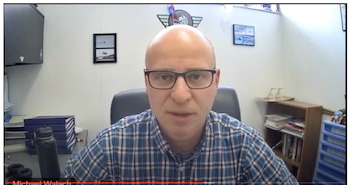Engineering Lesson 15: Flight conclusion
This lesson covers the conclusion of a launch, including chase and recovery; wrapping up a field campaign; data analysis; and communicating science to peers and the public.
Overview of the content
This lesson includes an important video about contingency planning.....thinking ahead about everything that could go wrong on flight day, from tiny details to big situations.
This lesson will also help you better understand how to organize and analyze the data from your flights, whether that is numerical data or photographic/video data.
You will learn to save data in csv format and retreive it for analysis using MS Excel; generate a "time since launch" column based on either real time or relative time columns (and a launch indicator, like pressure); use timing (possibly not prefectly calibrated) to combine data from different sources (like video footage, gps tracker, data log (without gps tags)); generate basic graphs (and look over "the shape of data" quickly) using MS Excel; and use gpsvisualizer.com to generate 3D trajectory plots from a gps data set.
Several video tutorials are provided.
Learning objectives
After completing this lesson, students will be able to:
Contingency planning
- List and consider all the possible things that could go wrong on flight day (or the days leading up to it) and create a plan for how to best mitigate the risk of each.
Flight conclusion
- Explain the process of terminating a flight.
- Explain the problems that can arise from a balloon bursting vs. being intentionally terminated.
- Describe the recovery process.
- Explain recovery problems specific to the area you plan to fly.
- Detail how you will approach land owners and gain permission to cross private land.
- Describe the steps that need to be taken after a flight to secure and record flight data.
Data analysis
- Save data in .csv format and retrieve it for analysis using Microsoft Excel
- Generate a "time since launch" column
- Use timing to combine data from multiple sources
- Generate basic graphs using Excel
- Use gpsvisualizer.com to generate 3D trajectory plots.
Contingency Planning
Landing and recovery
NEBP: Landing/recovery for engineering teams. [YouTube, closed captioned, 14:16]
In this video, Dr. James Flaten (University of Maryland) and Dr. Mary Bowden (University of Maryland) discuss the various situations that may occur when landing/recovering an engineering team balloon,
Video analysis and data plotting
Introduction to Video Analysis and Data Plotting with Excel - by Dr. James Flaten [YouTube, closed captioned, 19 min]
Suggested in-class activity
Do some basic analysis on video clips and gps data (from an Iridium tracker) and sensor data (from a PTERODACTYL flight computer) from an actual stratospheric balloon flight.
Extended learning
Students who wish to continue to work with data can continue with sample data analysis. The instructor could ask students to do "second-order" tasks like fitting ascent vs time (for ascent, float, and descent separately) then applying the fits to add a "fit altitude" column to a data set that does not have gps tags.
Communicating science to peers and the public
This video by Dr. Justin Minder of the University of Albany, a member of our NEBP team, includes a case study of how his team communicated the results of their field campaign through public outreach and academic communication.
Communicating to the public and peers - by Dr. Justin Minder [YouTube video, 2:29, closed captioned]
![]() Don't forget to track today's progress in your portfolio
Don't forget to track today's progress in your portfolio
Will you take a few minutes to give us some feedback on this lesson? Thank you!


